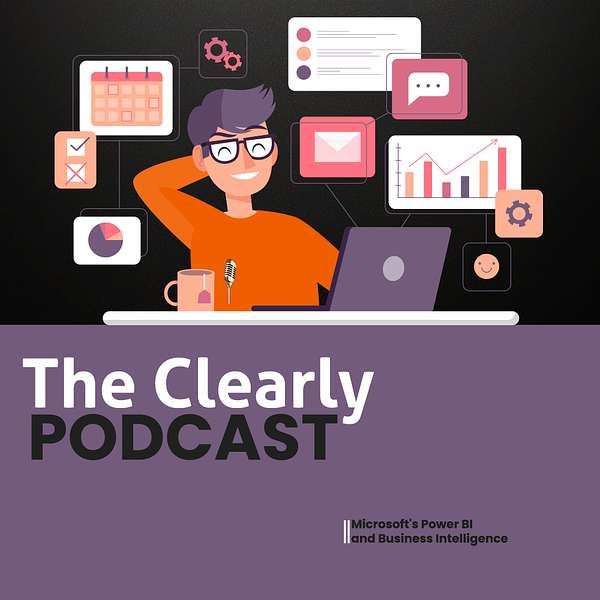
The Clearly Podcast
The Clearly Podcast
Azure vs Fabric
Welcome to the Clearly Podcast. After some light-hearted banter about annual leave and running shoes, the discussion shifts to the main topic: Azure vs. Fabric.
The conversation covers the components of Azure and Fabric, focusing on Power BI, Azure Data Factory (ADF), OneLake, and Synapse Analytics. Fabric offers better integration and cost control for users who need multiple components. However, for those using a single component like ADF, the benefits of migrating to Fabric are less clear.
From a customer perspective, streamlining licencing and management is a significant advantage of Fabric. Azure requires separate licences for each component, while Fabric consolidates this into a single licence. This can simplify administration and reduce costs, especially for future expansions.
For on-premise customers considering a move to the cloud, the best approach might be a gradual shift. First, migrate to Azure components, then transition to Fabric. This incremental strategy minimizes service interruptions and spreads out the rearchitecture workload.
There are also scenarios where sticking with Azure might be more practical. If an organization primarily uses components like ADF for non-analytical purposes, the complexity of managing Fabric could outweigh the benefits. The consensus is that while Fabric offers significant advantages for data analytics, Azure components will continue to cater to other use cases, and there is no immediate push for all customers to move to Fabric.
In summary, customers should evaluate their specific needs, considering both immediate and future use cases, to decide between Azure and Fabric. The transition should be planned carefully, leveraging Azure as a stepping stone when moving from on-premise environments.
Andy: Welcome to the Clearly Podcast. My name is Andy.
Shailan: I'm Shailan .
Tom: And I'm Tom.
Andy: Tom, who was that voice we just heard? I don't recognize it.
Tom: I think someone sneaked in here. You need to check who you're inviting, Andy.
Andy: I know. We've had Greg, who was great, and Terry, who was fantastic. Now, we have someone new.
Shailan: It's called annual leave. We're entitled to it.
Andy: You're right. Welcome back, my friend. Always a pleasure.
Tom: Yes, welcome back. You've been doing a lot of running too, haven't you?
Shailan: Absolutely, another one coming up soon.
Andy: Apparently, you have a business to run too.
Tom: Yes, testing running shoes seems to be your side gig.
Shailan: Yes, I need new running shoes.
Andy: How often do you change your running shoes?
Shailan: Probably not often enough. I need trail shoes for better balance.
Andy: I have some New Balance Hero shoes coming.
Shailan: Nice.
Andy: We should move on to today's topic: Azure vs. Fabric. How do they coexist? Tom, this is your idea, so can you give us an overview?
Tom: Sure. We previously talked about Fabric and its components like Power BI, Azure Data Factory, OneLake, and Synapse Analytics. Today, we'll focus on how these components overlap and when it makes sense to use Azure vs. Fabric. The main argument for moving to Fabric is better integration and cost control. But if you're only using one component like Azure Data Factory, migrating to Fabric might not be worthwhile.
Andy: Shailan, what is the customer view on this? Are they clear on their plans?
Shailan: Good question. Customers often look to streamline their licencing. With Azure, you'd need separate licences for each component. Fabric offers a single F licence, which can simplify management and potentially reduce costs, especially if you plan to use multiple components in the future.
Tom: There are also administrative benefits. Managing everything through one portal in Fabric is simpler than managing multiple Azure components separately.
Andy: What about customers currently on-premise and considering a move to Fabric?
Tom: For on-premise customers, moving directly to Fabric means a complete rearchitecture, which is a big task. A more manageable approach is moving first to Azure components, like SQL Managed Instances and ADF, and then gradually shifting to Fabric. This minimizes service interruption.
Shailan: Yes, and Microsoft sometimes offers incentives, like free hosting for a year when moving from on-premise to Azure. It's important to have workshops with stakeholders and SMEs to understand all the current processes and ensure a smooth transition.
Andy: Tom, you mentioned several common components like Power BI, ADF, Synapse, and storage. Why might some organizations decide against moving to Fabric?
Tom: If an organization only uses one component, the added complexity of managing all Fabric services might not be worth it. For example, if they're only using ADF for data movement, sticking with Azure might be simpler. But for those heavily into analytics, Fabric's integrated approach could be beneficial.
Andy: Do you think Fabric might eventually encompass all these components?
Tom: Unlikely. Some components, like Data Lake Storage, have use cases outside analytics. Removing these from Azure would push users towards AWS or other alternatives. It's more likely that Azure and Fabric will continue to coexist, catering to different needs.
Andy: So, customers shouldn't worry about being forced into Fabric?
Tom: Correct. Azure components will likely remain available for those who don't need the full Fabric suite.
Andy: Great. Shailan, any final thoughts?
Shailan: Key points: evaluate use cases, consider consolidation of licencing, and understand that migrating from Azure to Fabric is simpler than moving directly from on-premise.
Tom: Absolutely. Moving to Fabric from Azure can be a relatively smooth process. For on-premise, use Azure as a stepping stone. Also, remember that each organization's needs are different.
Andy: Perfect. Thanks, everyone. Next week, we hope to have a special guest, but if not, we'll have another topic ready. No ****** around!